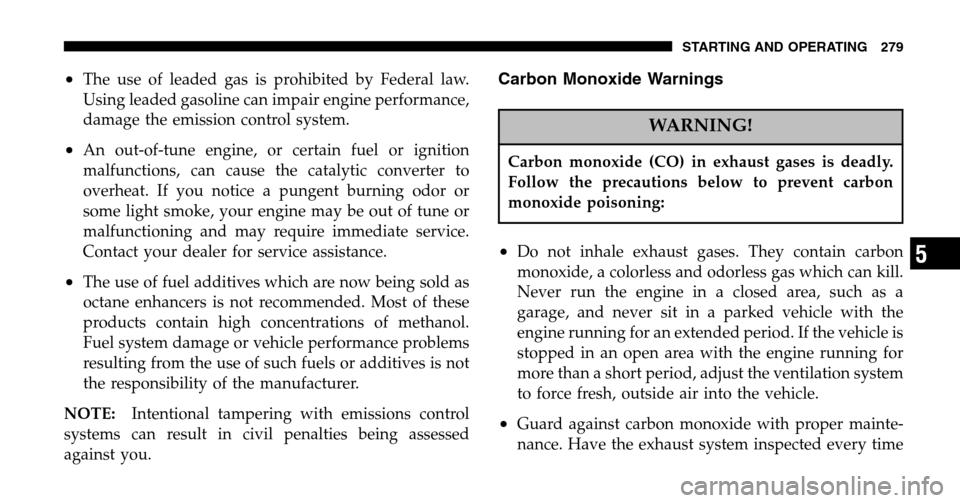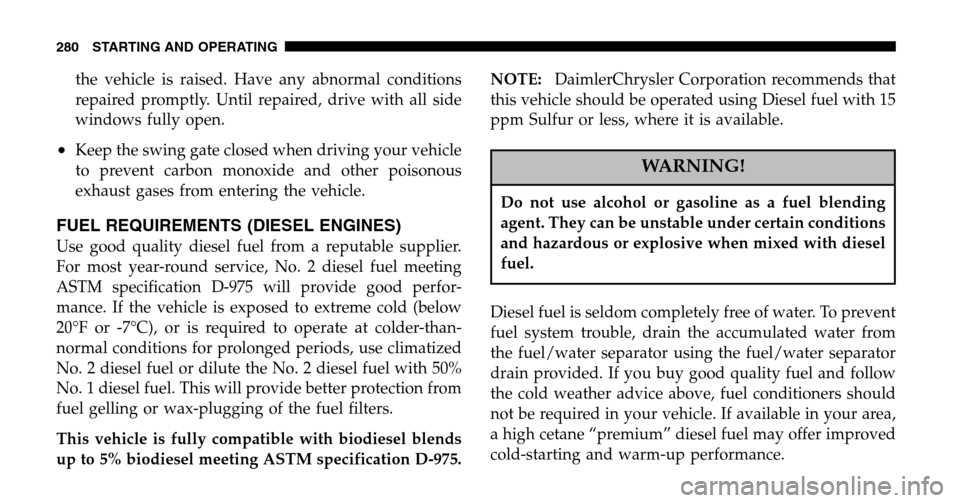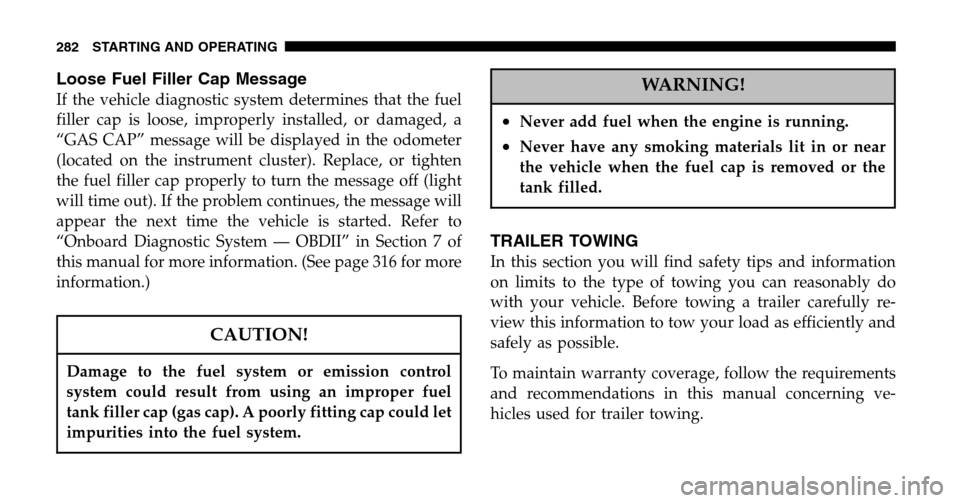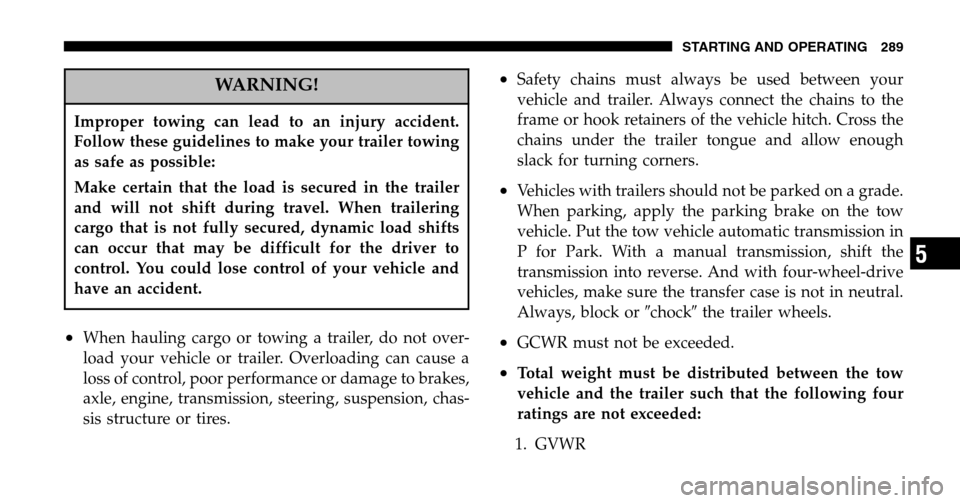Page 276 of 424
2.8L Turbo Diesel Engines
Rotate the tires every 6,000 miles (10 000 km).
NOTE: The Premium Tire Pressure Monitor System will
automatically locate the pressure values displayed in the
correct vehicle position following a tire rotation.
The suggested rotation method is the “forward-cross”
shown in the following diagram.FUEL REQUIREMENTS (GASOLINE ENGINES)
Your engine is designed to meet all emis-
sions regulations and provide excellent
fuel economy and performance when us-
ing high quality unleaded gasoline having
an octane rating of 87. The use of premium
gasoline is not recommended. The use of
premium gasoline will provide no benefit over high
quality regular gasoline, and in some circumstances may
result in poorer performance.
Mid-grade gasoline (89 octane) will enhance engine per-
formance during the following conditions (3.7L Only):
•Hot weather
•Towing
•Hard accelerations
•Hilly terrain
276 STARTING AND OPERATING
Page 277 of 424

•Low humidity
Light spark knock at low engine speeds is not harmful to
your engine. However, continued heavy spark knock at
high speeds can cause damage and immediate service is
required.
Poor quality gasoline can cause problems such as hard
starting, stalling and hesitations. If you experience these
symptoms, try another brand of gasoline before consid-
ering service for the vehicle.
Over 40 auto manufacturer’s world wide have issued and
endorsed consistent gasoline specifications (the World-
wide Fuel Charter, WWFC) to define fuel properties
necessary to deliver enhanced emissions, performance,
and durability for your vehicle. The manufacturer recom-
mends the use of gasoline that meets the WWFC speci-
fications if they are available.Reformulated Gasoline
Many areas of the country require the use of cleaner
burning gasoline referred to as Reformulated Gasoline.
Reformulated gasoline contains oxygenates, and is spe-
cifically blended to reduce vehicle emissions and im-
prove air quality.
The manufacturer strongly supports the use of reformu-
lated gasoline. Properly blended reformulated gasoline
will provide excellent performance and durability for the
engine and fuel system components.
Gasoline/Oxygenate Blends
Some fuel suppliers blend unleaded gasoline with oxy-
genates such as 10% ethanol, MTBE, and ETBE. Oxygen-
ates are required in some areas of the country during the
winter months to reduce carbon monoxide emissions.
Fuels blended with these oxygenates may be used in
your vehicle.
STARTING AND OPERATING 277
5
Page 279 of 424

•The use of leaded gas is prohibited by Federal law.
Using leaded gasoline can impair engine performance,
damage the emission control system.
•An out-of-tune engine, or certain fuel or ignition
malfunctions, can cause the catalytic converter to
overheat. If you notice a pungent burning odor or
some light smoke, your engine may be out of tune or
malfunctioning and may require immediate service.
Contact your dealer for service assistance.
•The use of fuel additives which are now being sold as
octane enhancers is not recommended. Most of these
products contain high concentrations of methanol.
Fuel system damage or vehicle performance problems
resulting from the use of such fuels or additives is not
the responsibility of the manufacturer.
NOTE: Intentional tampering with emissions control
systems can result in civil penalties being assessed
against you.
Carbon Monoxide Warnings
WARNING!
Carbon monoxide (CO) in exhaust gases is deadly.
Follow the precautions below to prevent carbon
monoxide poisoning:
•Do not inhale exhaust gases. They contain carbon
monoxide, a colorless and odorless gas which can kill.
Never run the engine in a closed area, such as a
garage, and never sit in a parked vehicle with the
engine running for an extended period. If the vehicle is
stopped in an open area with the engine running for
more than a short period, adjust the ventilation system
to force fresh, outside air into the vehicle.
•Guard against carbon monoxide with proper mainte-
nance. Have the exhaust system inspected every time
STARTING AND OPERATING 279
5
Page 280 of 424

the vehicle is raised. Have any abnormal conditions
repaired promptly. Until repaired, drive with all side
windows fully open.
•Keep the swing gate closed when driving your vehicle
to prevent carbon monoxide and other poisonous
exhaust gases from entering the vehicle.
FUEL REQUIREMENTS (DIESEL ENGINES)
Use good quality diesel fuel from a reputable supplier.
For most year-round service, No. 2 diesel fuel meeting
ASTM specification D-975 will provide good perfor-
mance. If the vehicle is exposed to extreme cold (below
20°F or -7°C), or is required to operate at colder-than-
normal conditions for prolonged periods, use climatized
No. 2 diesel fuel or dilute the No. 2 diesel fuel with 50%
No. 1 diesel fuel. This will provide better protection from
fuel gelling or wax-plugging of the fuel filters.
This vehicle is fully compatible with biodiesel blends
up to 5% biodiesel meeting ASTM specification D-975. NOTE:
DaimlerChrysler Corporation recommends that
this vehicle should be operated using Diesel fuel with 15
ppm Sulfur or less, where it is available.
WARNING!
Do not use alcohol or gasoline as a fuel blending
agent. They can be unstable under certain conditions
and hazardous or explosive when mixed with diesel
fuel.
Diesel fuel is seldom completely free of water. To prevent
fuel system trouble, drain the accumulated water from
the fuel/water separator using the fuel/water separator
drain provided. If you buy good quality fuel and follow
the cold weather advice above, fuel conditioners should
not be required in your vehicle. If available in your area,
a high cetane “premium” diesel fuel may offer improved
cold-starting and warm-up performance.
280 STARTING AND OPERATING
Page 281 of 424
FUEL TANK FILLER CAP (GAS CAP)
CAUTION!
•To avoid fuel spillage and overfilling, do not “top
off” the fuel tank after filling.
•DO NOT put gasoline in your diesel vehicle (if
equipped). If you accidentally put gasoline in
your vehicle, DO NOT start the engine. This will
cause damage to the fuel system. Have the fuel
system flushed.
The gas cap is located behind the fuel filler door, on the
left side of the vehicle. If the gas cap is lost or damaged,
be sure the replacement cap has been designed for use
with this vehicle. When tightening the gas cap, tighten until 2 or 3 clicks
are heard to insure that the cap is properly seated.
Fuel Filler Cap
STARTING AND OPERATING 281
5
Page 282 of 424

Loose Fuel Filler Cap Message
If the vehicle diagnostic system determines that the fuel
filler cap is loose, improperly installed, or damaged, a
“GAS CAP” message will be displayed in the odometer
(located on the instrument cluster). Replace, or tighten
the fuel filler cap properly to turn the message off (light
will time out). If the problem continues, the message will
appear the next time the vehicle is started. Refer to
“Onboard Diagnostic System — OBDII” in Section 7 of
this manual for more information. (See page 316 for more
information.)
CAUTION!
Damage to the fuel system or emission control
system could result from using an improper fuel
tank filler cap (gas cap). A poorly fitting cap could let
impurities into the fuel system.
WARNING!
•Never add fuel when the engine is running.
•Never have any smoking materials lit in or near
the vehicle when the fuel cap is removed or the
tank filled.
TRAILER TOWING
In this section you will find safety tips and information
on limits to the type of towing you can reasonably do
with your vehicle. Before towing a trailer carefully re-
view this information to tow your load as efficiently and
safely as possible.
To maintain warranty coverage, follow the requirements
and recommendations in this manual concerning ve-
hicles used for trailer towing.
282 STARTING AND OPERATING
Page 286 of 424

Engine/
Transmission Model
GVWR
(Gross Vehicle Wt.
Rating) GCWR
(Gross Combined
Wt. Rating) Frontal Area
Max. GTW
(Gross Trailer Wt.) Max.
Tongue Wt.
(See Note 1)
3.7L/6-Speed Manual 4x2 5,350 lbs (2 427 kg) 8,500 lbs (3 855 kg) 40 Sq. Ft. (3.72
square meters) 3,500 lbs (1 587 kg) 350 lbs (159 kg)
3.7L/6-Speed Manual 4x4 5,600 lbs (2 540 kg) 8,750 lbs (3 969 kg) 40 Sq. Ft. (3.72
square meters) 3,500 lbs (1 587 kg) 350 lbs (159 kg)
3.7L/
Automatic 4x2 5,350 lbs (2 427 kg) 7,150 lbs (3 243 kg) 32 Sq. Ft. (2.97
square meters) 2,000 lbs (907 kg) 200 lbs (91 kg)
3.7L/
Automatic 4x4 5,600 lbs (2 540 kg) 7,400 lb
s ( 3 356 kg) 32 Sq. Ft. (2.97
square meters) 2,000 lbs (907 kg) 200 lbs (91 kg)
3.7L/
Automatic
w/ Cooler 4x2 5,350 lbs (2 427 kg) 9,850 lbs (4 468 kg) 60 Sq. Ft. (5.57
square meters) 5,000 lbs (2 268 kg) 500 lbs (227 kg)
3.7L/
Automatic w/Cooler 4x4 5,600 lbs (2 540 kg) 10,100 lbs (4 581 kg) 60 Sq. Ft. (5.57
square meters) 5,000 lbs (2 268 kg) 500 lbs (227 kg)
2.8L Diesel/ Automatic 4x4 5,650 lbs (2 563 kg) 10,150 lbs (4 604 kg) 60 Sq. Ft. (5.57
square meters) 5,000 lbs (2 268 kg) 500 lbs (227 kg)
Refer to local laws for maximum trailer towing speeds.
286 STARTING AND OPERATING
Page 289 of 424

WARNING!
Improper towing can lead to an injury accident.
Follow these guidelines to make your trailer towing
as safe as possible:
Make certain that the load is secured in the trailer
and will not shift during travel. When trailering
cargo that is not fully secured, dynamic load shifts
can occur that may be difficult for the driver to
control. You could lose control of your vehicle and
have an accident.
•When hauling cargo or towing a trailer, do not over-
load your vehicle or trailer. Overloading can cause a
loss of control, poor performance or damage to brakes,
axle, engine, transmission, steering, suspension, chas-
sis structure or tires.
•Safety chains must always be used between your
vehicle and trailer. Always connect the chains to the
frame or hook retainers of the vehicle hitch. Cross the
chains under the trailer tongue and allow enough
slack for turning corners.
•Vehicles with trailers should not be parked on a grade.
When parking, apply the parking brake on the tow
vehicle. Put the tow vehicle automatic transmission in
P for Park. With a manual transmission, shift the
transmission into reverse. And with four-wheel-drive
vehicles, make sure the transfer case is not in neutral.
Always, block or �chock�the trailer wheels.
•GCWR must not be exceeded.
•Total weight must be distributed between the tow
vehicle and the trailer such that the following four
ratings are not exceeded:
1. GVWR
STARTING AND OPERATING 289
5